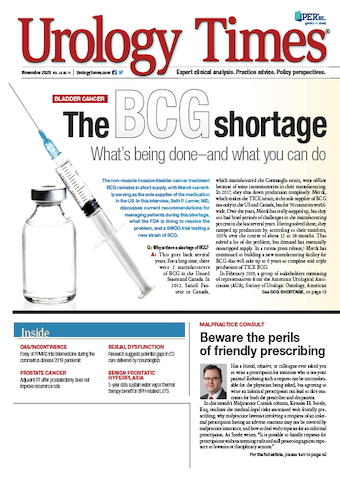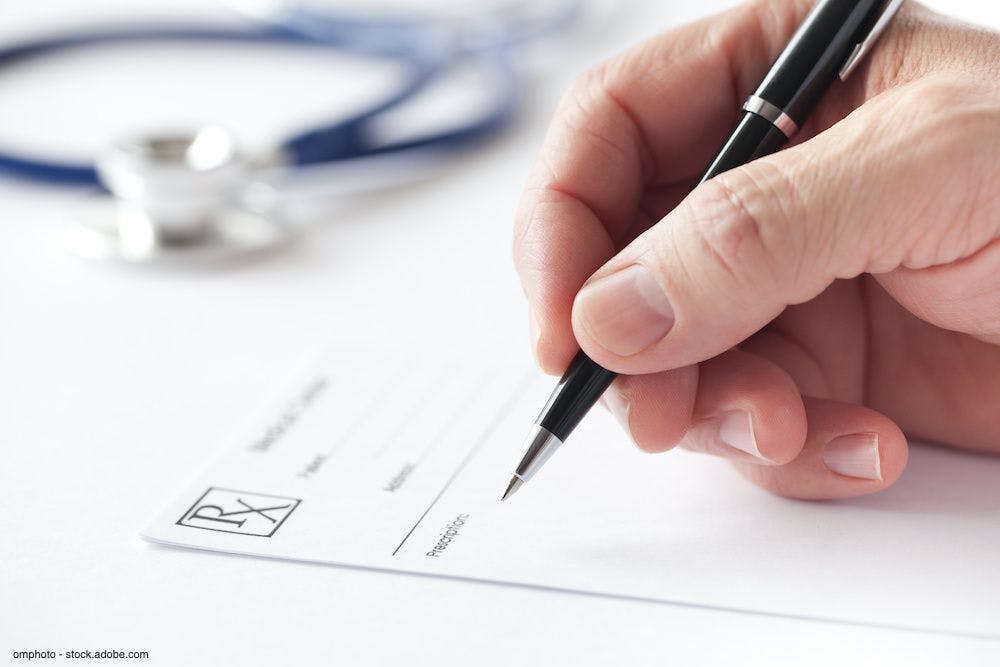Publication
Article
Urology Times Journal
The BCG shortage: What's being done—and what you can do
Author(s):
In this interview, Seth P. Lerner, MD, discusses current recommendations for managing patients during the BCG shortage, what the FDA is doing to resolve the problem, and a SWOG trial testing a new strain of BCG.
Seth P. Lerner, MD

The non–muscle invasive bladder cancer treatment BCG remains in short supply, with Merck currently serving as the sole supplier of the medication in the US. In this interview, Seth P. Lerner, MD, discusses current recommendations for managing patients during this shortage, what the FDA is doing to resolve the problem, and a SWOG trial testing a new strain of BCG.
Lerner is professor of urology, Beth and Dave Swalm Chair in Urologic Oncology, director of urologic oncology, and director of the multidisciplinary bladder cancer program at Baylor College of Medicine, Houston, Texas. He was interviewed by Urology Times® Editorial Consultant J. Brantley Thrasher, MD, executive director of the American Board of Urology, Charlottesville, Virginia.
Disclosures: Dr Lerner has conducted clinical trials for Endo, FKD Therapies, JBL Science, Roche/Genentech, UroGen Pharma, Vaxiion Therapeutics, Viventia Bio Inc; is a consultant/advisor for FerGene, Genentech, Merck, Pfizer/EMD Serono, QED Therapeutics, UroGen Pharma, Vaxiion Therapeutics, and Verity Pharmaceuticals; has received honoraria from Grand Rounds Urology and UroToday; and holds a patent for The Cancer Genome Atlas Classifier.
Why is there a shortage of BCG?
This goes back several years. For a long time, there were 2 manufacturers of BCG in the United States and Canada. In 2012, Sanofi Pasteur in Canada, which manufactured the Connaught strain, went offline because of some inconsistencies in their manufacturing. In 2017, they shut down production completely. Merck, which makes the TICE strain, is the sole supplier of BCG not only in the US and Canada, but for 70 countries worldwide. Over the years, Merck has really stepped up, but they too had brief periods of challenges in the manufacturing process in the last several years. Having solved these, they ramped up production by, according to their numbers, 100% over the course of about 12 to 18 months. That solved a lot of the problem, but demand has essentially outstripped supply. In a recent press release,1 Merck has committed to building a new manufacturing facility for BCG that will take up to 6 years to complete and triple production of Tice BCG.
In February 2019, a group of stakeholders consisting of representatives from the American Urological Association, Society of Urologic Oncology, American Association of Clinical Urologists, the Urology Care Foundation, LUGPA, and the Bladder Cancer Advocacy Network (BCAN) met with representatives from Merck at the GU Cancers Symposium. We crafted a joint statement to try to help urologists manage patients during this shortage. We provided some guidelines to prioritize BCG for the patients who most needed it, such as patients with high-risk, high-grade non-muscle-invasive disease at their first diagnosis. Getting those patients through the induction and the first 3 months of maintenance treatments is critical. For patients who have already had a year or two of maintenance, we recommend curtailing that treatment.
With the statement, we were also trying to help urologists look for alternatives to BCG; namely intravesical chemotherapy for patients with intermediate-risk disease, where there’s less of a distinction about the superiority of BCG over chemotherapy. We’re trying to help urologists understand the AUA guidelines and where we think BCG can be most effective. But despite all of these efforts, the shortage persists, so we have to look for other strategies to help solve the problem.
What are the recommendations for urologists currently?
In high-risk patients for whom clinicians do not have access to BCG, we recommend a combination of chemotherapy drugs that can be delivered intravesically. We’re currently using gemcitabine and docetaxel. This combination was originated by Dr Michael O’Donnell at the University of Iowa, and a number of centers are using it quite successfully for patients for whom we don’t have BCG, or for patients who recur, after induction and one round of maintenance where they don’t necessarily need to go on to a cystectomy.
Another strategy is to extend the use of a vial of BCG by dividing it into 2 or even 3 doses. There’s actually a J code for that, but unfortunately, the payors haven’t given us a way to charge for that appropriately. This remains a challenge for many practices, and efforts are needed to resolve this with CMS and other payors. Another strategy is proper use of perioperative single-dose chemotherapy for low- and intermediate-risk patients to try to reduce the risk of recurrence and the subsequent need for BCG. A recent SWOG trial showed that a single dose of peri-operative intravesical gemcitabine, reduced the risk of recurrence by almost 50% at 4 years in patients with low-grade disease.2 In patients with intermediate-risk disease—patients with multi focal or recurrent Ta low grade cancer—an optimized regimen of mitomycin C first described in 2001 is easy to use and improves the efficacy of mitomycin.3
What is the FDA doing to help address the shortage?
The FDA is being very proactive. They fully recognize and appreciate the importance of solving this problem. The group of stakeholders that met at the 2019 GU Cancers Symposium convened again at the 2020 symposium. There were 2 representatives from the FDA at that meeting, and they expressed a very strong interest in working with us and anyone else in the community to try to solve this shortage.
The reality of it is that we need to get new strains of BCG into the US market. They have to go through the standard FDA approval process. In the Southwest Oncology Group, we’re currently conducting a trial led by Dr Robert Svatek (NCT03091660). This is a 3-arm, 969-patient trial for patients who have high-risk, high-grade disease and are BCG naive. In the control arm, patients receive induction and maintenance TICE BCG, which is the current standard of care. We have a contract with Merck to guarantee the supply of Tice BCG for this trial. Patients in the other 2 arms receive the Tokyo-172 strain that was developed in Japan and has been around for decades. There are data suggesting that it is equivalent in efficacy to the Connaught strain and we will compare the efficacy of the Tokyo strain to Tice. We are also evaluating intradermal vaccination to prime the immune system prior to starting BCG treatment in order to improve the response rate. Failure-free survival at 1 year is the primary outcome measure. Two thirds of patients receive intravesical Tokyo-172, and half of those patients get vaccinated with Tokyo-172 BCG.
We’ve had multiple conversations with the FDA regarding the trial. They are very interested in looking at the patients with carcinoma in situ, who make up about one third of the patients in this trial. If the data support the efficacy of the Tokyo-172 strain for these patients, it’s a potential pathway for regulatory approval for this BCG strain.
Companies are looking at bringing other strains into the US market. One company is looking at the Russian strain, which is used mostly in Europe and other parts of the world. They will also have to go through a very strict FDA review and approval process.
Are there data to suggest a protective effect against bladder cancer in patients who have been vaccinated with BCG?
I’m not sure how well that’s been studied. We won’t be able to answer that question in our trial, because previous vaccination is one of the exclusion criteria. The trial design was based upon Dr Matthew Albert’s work from the Institut Pasteur.4 He and his colleagues compared induction BCG in patients who were previously vaccinated and those who were not, and the vaccinated patients seemed to do a lot better but that was with induction only and no maintenance BCG. Conceptually, the idea is that you prime the immune system with vaccination 3 weeks prior to intravesical BCG, so that, where it normally takes between 4-6 intravesical instillations during induction to reach peak cytokine induction, we think that that would happen much earlier, and by virtue of that, yield better outcomes in terms of failure-free survival.
You mentioned a couple of ways to potentially to relieve the stress on urologists who can’t obtain BCG. Is there a role for thiotepa, adriamycin, valrubicin, and some of the other agents that have been used in the past?
I think most urologists should be comfortable using mitomycin and gemcitabine. Here in Houston and the surrounding area, we’ve been very happy to guide clinicians in the use of intravesical chemotherapy drugs that they may not have a lot of experience with, particularly these combinations. I would say that if you don’t have experience, then simply reach out to your nearest academic urology department for guidance. These are really easy to use. We’re available for consultation, guidance, and treatment, if needed. I think most of us are in a situation where we currently have adequate BCG supply, but I’m still getting referrals for patients in my community from physicians who don’t have access to BCG.
You mentioned boosting the immune system. I understand that you are involved with a trial evaluating BCG vaccinations for COVID-19.
Yes, this is something that a number of us have become involved with. Infectious disease experts here in the US, the Netherlands and Australia have done a lot of work in this space, conducting research on BCG vaccination for tuberculosis globally. They observed that, epidemiologically, countries that had programmatic vaccination for tuberculosis from birth had about a ten-fold lower incidence of COVID-19 and about a ten-fold reduction in mortality rate compared with countries that did not have programmatic vaccination from birth.5 There is a fair amount of laboratory and experimental evidence to support why that might be. There are nonspecific immune effects of BCG vaccination that have been shown to reduce the risk of bacterial and viral respiratory infections, particularly yellow fever, which is another virally transmitted disease. The experimental evidence suggests that BCG causes epigenetic modification of immune cells that make them perhaps more alert to other foreign viruses; in this particular case, the novel coronavirus causing COVID-19.
As a result, the infectious disease community has put together randomized clinical trials comparing BCG vaccination to placebo, initially focusing on the highest risk health care workers, first responders and the elderly. The trial that I am involved with is a collaboration with Baylor College of Medicine, MD Anderson Cancer Center (Ashish Kamat, MD, is one of the principal investigators), Texas A&M University, Cedars-Sinai Medical Center, and Harvard University (NCT04348370). This was largely conceived of and led by the infectious disease community, but they logically tapped into the urologic community because we have experience with BCG. The primary outcome measure is incidence of COVID-19, and the secondary outcome measure is disease severity. We do not feel these trials will have a material negative impact on BCG supply as a single vial that is used for 1 treatment of BCG in a patient with bladder cancer can vaccinate up to 500 subjects.
Is there anything else you’d like to add?
I serve on the board of directors for the Bladder Cancer Advocacy Network (BCAN). They have been very active in calling attention to the BCG shortage and trying to develop strategies for patients who face many challenges navigating this complex situation.
As a community, we must always be sensitive to the needs of patients, and work very closely with them. Consider a patient who is out 12 or 18 months and never recurred, receiving their maintenance BCG and surveillance cystoscopies. Then their doctor tells them that, in order to manage this shortage, their treatment is being stopped. That can come as a big shock to patients, and it can create a lot of concern and anxiety. We can reassure them that they have already received most of the benefit and will continue close surveillance. In addition, we need to use BCG only for the highest risk patients. That will go a long way towards helping manage the shortage. Finally, we need to support clinical trials that could lead to getting new strains into the market as well as clinical trials evaluating other drugs that could be used to treat patients with alternative agents if shown to be as effective as BCG.
References
1. Merck announces plans to construct new facility in the united states to expand manufacturing capacity for TICE BCG. Press release. Merck. October 14, 2020. Accessed October 15, 2020. https://bit.ly/2HBYJhW
2. Messing EM, Tangen CM, Lerner SP, et al. Effect of intravesical instillation of gemcitabine vs saline immediately following resection of suspected low-grade non–muscle-invasive bladder cancer on tumor recurrence SWOG S0337 randomized clinical trial. JAMA. 2018;319(18):1880-1888. doi:10.1001/jama.2018.4657.
3. Au JL, Badalament RA, Wientjes MG, et al. Methods to improve efficacy of intravesical mitomycin C: results of a randomized phase III trial. J Natl Cancer Inst. 2001;93(8):597-604. doi:10.1093/jnci/93.8.597
4. Biot C, Rentsch CA, Gsponer JR, et al. Preexisting BCG-specific T cells improve intravesical immunotherapy for bladder cancer. Sci Transl Med. 2012;4(137):137ra72. doi:10.1126/scitranslmed.3003586
5. Hegarty PK, Sfakianos JP, Giannarini G, et al. COVID-19 and bacillus Calmette-Guérin: What is the link? Eur Urol Oncol. 2020;3(3):259-261. doi:10.1016/j.euo.2020.04.001

Newsletter
Stay current with the latest urology news and practice-changing insights — sign up now for the essential updates every urologist needs.





















